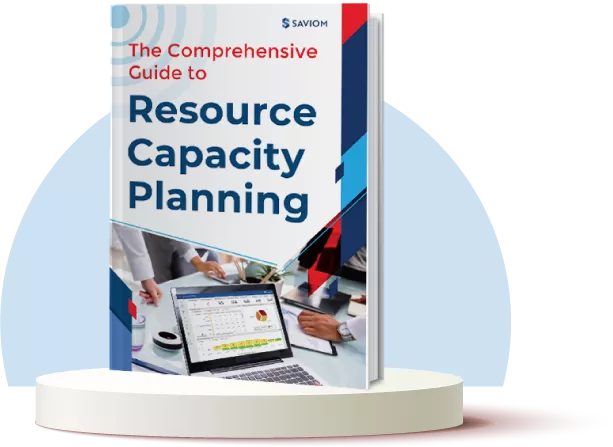Picture this: A project is well into its execution phase, yet uncertainty clouds the team. The members are confused about their roles & responsibilities, key deadlines are slipping, and the manager is scrambling for critical resources at the last minute. So, what went wrong? At the core of the chaos lies the problem – a lack of proper team planning.
When team members lack clarity on how to proceed, even the most talented individuals may struggle to perform effectively. However, with proper team planning in place, the firm can align these scattered efforts to a coordinated execution. This drives greater efficiency, fosters accountability, and helps achieve key business outcomes successfully.
In this blog, we will dive into details of team planning, such as definition, benefits, key stakeholders, steps, and best practices.
Let’s begin!
What is Team Planning?
Team planning is a structured process of aligning the team’s efforts with operational and strategic plans to achieve organizational objectives within a defined timeframe. It involves setting team goals, determining necessary competencies, assigning roles & responsibilities, etc., to support key business priorities.
When done right, effective team planning facilitates competent team allocation, fosters cross-collaboration, and improves employee productivity. Consequently, it promotes team cohesion, enhances decision-making, and drives measurable outcomes, ultimately leading to successful project delivery.
Let us understand it better through an example.
Team Planning Example
Imagine this: an internal IT team at a fast-growing software product company is expanding into international markets. The company plans to scale its development and support teams across multiple regions.
To accomplish this objective, the IT team lays out a structured team plan:
- Annual Goal: Standardize IT infrastructure across five new global offices by year-end.
- Quarterly Goal: Deploy a secure VPN and access management system for remote teams.
- Monthly Goal: Onboard 50+ new developers with device setup and system access.
- Weekly Tasks: Troubleshoot connectivity issues, manage device inventory, and update access logs.
- Roles Clarified: One person handles onboarding, another manages systems and security, and a third supports user requests.
With this clarity, the IT team becomes a strategic partner in enabling seamless growth, not just a reactive support function.
Now, let us see the elements that are required for effective team planning.
9 Elements for Effective Team Planning
Listed below are the few elements that will help in effective team planning:
Purpose & Vision
For strong team planning, managers must first define a clear purpose and vision to achieve business goals. The purpose helps clarify the team’s role and informs how their individual efforts contribute to greater organizational objectives. Meanwhile, vision sets the direction for future growth and innovation. Together, these elements foster team focus, drive motivation and encourage accountability.
Roles & Responsibilities
Managers must ensure everyone on the team clearly understands their specific roles and individual responsibilities. This insight boosts employee accountability, leading to higher quality of project deliverables and timely completion of work. As a result, teams stay organized and efficient, helping firms achieve their strategic goals more effectively.
Skills & Interests
Knowing what each team member is good at and what they actually enjoy doing makes a huge difference in team planning. When managers consider both skills and interests, they are not just filling roles; they are matching people to work that fits their individual strengths and passion. This alignment enhances engagement, improves employee performance, and drives successful project outcomes.
Read More: What is Skill Development? 10 Best Strategies to Build a Future-Ready Workforce
Timeframes & Milestones
Setting clear timeframes and milestones is critical for keeping projects on track. Timeframes help teams juggle project priorities and manage workloads effectively, while project milestones serve as checkpoints to monitor task progression and identify issues early. Together, they provide structure, maintain momentum, and ensure timely delivery of project goals.
Key Performance Indicators (KPIs)
KPIs help turn team goals into something more concrete and measurable. When managers can track certain KPIs like utilization rate, schedule variance, productivity, etc., it becomes easier for them to monitor progress and identify any areas of concern. This helps adjust plans early, set realistic targets, and ensure the team stays focused.
Resources’ Availability
Another vital element of team planning is ensuring the right resources are available at the right time to ensure timely project initiation. This involves identifying the number, type, and quantity of resources currently available to take on upcoming tasks. Based on this evaluation, plan and ensure that suitable resources are available on time to avoid any last-minute resourcing chaos.
Read More: What is Resource Availability in Project Management, and Why Does It Matter?
Communication plan
A clear communication plan outlines how the information will be shared among the relevant stakeholders throughout the project lifecycle. This includes details like the type of communication platform, frequency of updates, etc. As a result, this enables the team to avoid misunderstanding and drive swift and accurate decisions.
Risk & Contingency Planning
Resource-related bottlenecks like shortage/excess, unplanned time-off, skill gaps, etc., can easily affect even a well-structured plan. That’s why it’s essential to identify these risks early and have a clear contingency plan in place. With a proper risk mitigation plan, the project budget won’t be affected and will stay steady even when things don’t go as expected.
Review & Feedback Cycles
With everything in place, it’s important for managers to hold regular reviews and feedback cycles to identify any challenges the team might be facing. Regular check-ins keep the team aligned while also giving everyone a chance to voice their opinions, share ideas, and drive innovation. Thus, these small feedback loops gradually shape the way the team learns, adapts, and grows together.
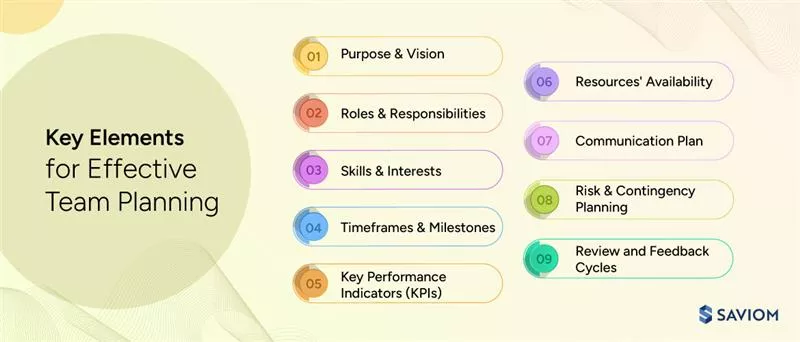
Now, let us move on to see the key stakeholders in the team planning process.
Key Stakeholders in the Team Planning Process
Here are key individuals who play an instrumental role in aligning the team with project goals and overall business priorities:
Project or Team Leader
Project or team leaders are critical point of contact between the senior management and the strategy/operational delivery team during the team planning process. These individuals oversee planning, allocate resources, foster collaborations, and ensure the team aligns with project goals.
Read More: Leadership in Project Management: 10 Tips to Become a Good Leader
Team Members
As key stakeholders, team members play a central role in the planning process. They are not just doers; they are often the ones with the clearest view of what’s happening on the ground. They bring in their practical insights that help shape realistic, workable plans. When everyone understands their roles and responsibilities, the team stays more focused, engaged, and aligned with the bigger goal.
Resource Manager
The resource manager operates at the organizational level and ensures that most resources under their span of control are allocated to business-critical projects at any given time. Simply put, their core responsibility is to ensure that the right resources are in the right place at the right time to drive successful project outcomes.
Read More: What is a Resource Manager? Key Responsibilities and Skills to Become a Successful One
Senior Manager
A senior leader helps make sure the team’s planning aligns with what the business is trying to achieve. This could be a department head or somebody in a leadership role responsible for turning high-level goals into clear, achievable actions. They collaborate closely with the team to communicate clear priorities and ensure the team has a practical roadmap to follow.
Third-Party Advisor
A third-party advisor can help bring some structure and a fresh perspective to the planning process, especially when large teams are involved. Their unique insights help sharpen the team’s focus and improve the overall planning quality. Furthermore, they also guide the session’s agenda, ensuring discussions stay on track and objectives are met.
Now that we know the stakeholders in the team planning process let us move on to the key benefits of team planning.
Key Benefits of Effective Team Planning
Listed below are a few benefits of team planning:
Aligns Team with Business Strategic Goals
Team planning ensures that the team’s work directly supports the bigger business objectives. By facilitating structured planning, managers gain an understanding of how teamwork contributes to broader business growth. This alignment helps them prioritize tasks that drive business value and improve operational efficiency.
Read More: 7 Top Business Benefits of Strategic Workforce Planning
Helps Identify the Right Resources for Tasks
During team planning, managers determine employee skills, competencies, roles, costs, etc., required to meet project goals. Simultaneously, they must evaluate internal capacity to assess if they have sufficient resources for the work ahead. If not, firms can take necessary resourcing measures to secure, identify, and assign the right resources to tasks for timely project initiation.
Facilitates Early Identification of Resource Constraints
Effective team planning gives managers visibility into upcoming project demands and existing resource capacity. This allows them to identify critical resource constraints, such as skill shortage or excess, talent gaps, etc., well in advance. With this foresight, firms can take timely resourcing measures action to address critical bottlenecks and ensure smooth project progression.
Optimizes Team’s Workload Distribution
Team planning involves assessing each employee’s skills, competencies, current and future workload, etc. These insights enable managers to distribute tasks and responsibilities fairly across the team. Consequently, this helps reduce stress, prevent burnout and disengagement, and improve overall workforce efficiency and productivity.
Read More: What is Workload Distribution, and Effective Strategies to Improve it
Promotes Continuous Development & Team Growth
A well-structured team plan offers managers a clearer picture of each team member’s strengths, interests, skill gaps, etc. This makes it easier for organizations to organize suitable training and development programs that align with both individual aspirations and broader business goals. Over time, this approach helps build a more skilled, adaptable, and future-ready team.
Improves Employee Engagement & Productivity
When team members are given clarity on their roles & responsibilities, goals, and expectations, it fosters a sense of purpose and improves motivation. This transparency enhances ownership and simultaneously increases productivity levels. Moreover, when people work on tasks that match their interests, it subsequently boosts morale and deepens employee engagement.
Let us now move on to see the steps to create a robust team plan.
How to Create a Robust Team Plan?
A robust team plan is necessary for the firms to thrive and achieve their broader business goals. Here are a few effective steps to keep in mind while creating a team plan:
Define the Team’s Vision Statement
The first step in team planning is to craft a simple, meaningful vision statement that captures the essence of the team. It’s not just about goals; it’s about what drives the team and how they want to contribute to the larger mission. Moreover, involving team members in shaping this vision helps everyone feel connected, motivated, and focused on the goal.
Set Clear Goals and Objectives
Once the vision is clear, the next step is to define specific goals and objectives that support it. Goals show what the team wants to achieve, while objectives break down the steps or strategies to get there. Furthermore, aligning these with the company’s strategy ensures your team stays engaged and focused. This clarity improves decision-making and enhances overall resource productivity.
Assign Realistic Timelines to Each Objective
It is important that the team members are clear on the critical timelines, from initiation to closure, to help them stay organized and aligned. Setting realistic timelines for each objective helps provide a structure that helps the team to plan their efforts better. This prevents last-minute stress and maintains steady project momentum.
Read More: What is Project Duration? 7 Effective Ways to Estimate It Accurately
Rank and Prioritize Objectives Based on Impact
When building your team plan, it’s common to find that organizations don’t have sufficient capacity to match the volume of work at hand. In such cases, it becomes essential to rank and prioritize objectives based on strategic impact and overall business value. Consequently, it helps direct the team’s efforts toward what matters most and drives meaningful outcomes.
Identify Key Metrics to Track Performance
When drafting the team plan, it’s important for managers to define key performance indicators (KPIs) early on. These metrics include utilization rate, billable hours, or team productivity, which help track how efficiently the team is working toward its goals. Having clear KPIs not only shows what’s working but also makes it easier to spot gaps and take course-corrective actions promptly.
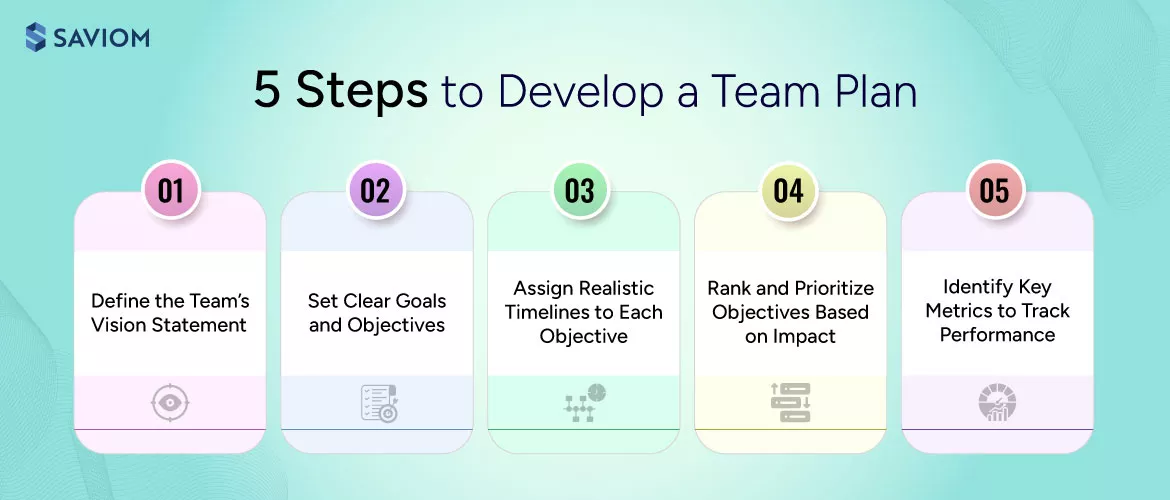
Now, let us see the best practices for a team planning session.
Best Practices to Improve a Team Planning Session
Here are a few best practices to make the process of team planning better:
Appoint a Skilled Facilitator
A skilled facilitator helps bring structure, neutrality, and momentum to the team planning process. Unlike a team lead or manager, they don’t have a stake in the outcome, allowing them to guide the conversation objectively and keep the discussions focussed.
They also encourage equal participation, especially from the quieter voices that would otherwise be overlooked. Thus, their presence helps the discussion stay productive, avoid unnecessary detours, and lead to clear decisions, ensuring nothing important falls through the cracks.
Start With a Strong Agenda
Having a clear agenda helps set expectations and keeps the meeting structured. It helps everyone know what to expect, keeps discussions on track, and avoids wasting time on unrelated topics. More importantly, it gives the team clarity on what needs to be done next.
For instance, a product team preparing for a major software launch has to coordinate across marketing, development, and sales. They follow a straightforward agenda that clearly outlines key discussion points in order of priority. It helps the team stay aligned, avoid confusion, and move forward with clear next steps.
Set a Positive Environment
During any team planning session, it’s important to set a positive environment for the team members to share their ideas without the fear of judgment. When people feel safe and respected, discussions become more productive and solution-focused. It also encourages better teamwork and fosters a collaborative environment.
For example, in a team planning session of a marketing team, the manager started by thanking everyone for their recent campaign efforts and encouraged the team to share one thing they were proud of. This small gesture lifted the mood, made everyone feel valued, and set the tone for an open, collaborative discussion.
Read More: 10 Ways to Improve Cross-Departmental Collaboration
Wrap Up with Clear Follow-Ups
Every team planning session must end with clear action items. Managers must ensure that every discussion point leads to concrete action, with task ownership and deadlines clearly defined. This helps minimize confusion, reinforces accountability, and ensures seamless project execution.
For instance, during a team planning session for an upcoming system upgrade, the IT services manager outlines the next steps and assigned responsibilities. The team documented everything in a shared tracker, making it easy to monitor progress, stay aligned on deadlines, and keep the project moving forward.
Next, let us see how resource management software helps in team planning.
How Can a Modern Resource Management Tool Help with Team Planning?
A robust resource management tool can help with team planning, enabling managers to achieve the strategic goals of a firm effectively. Here are its features that can help:
- The tool provides multi-dimensional analysis, which lets managers slice resource data by role, skill, location, cost, and more. It makes it easier to match the right people to the right tasks, ensuring smarter staffing decisions that fit the team’s needs perfectly.
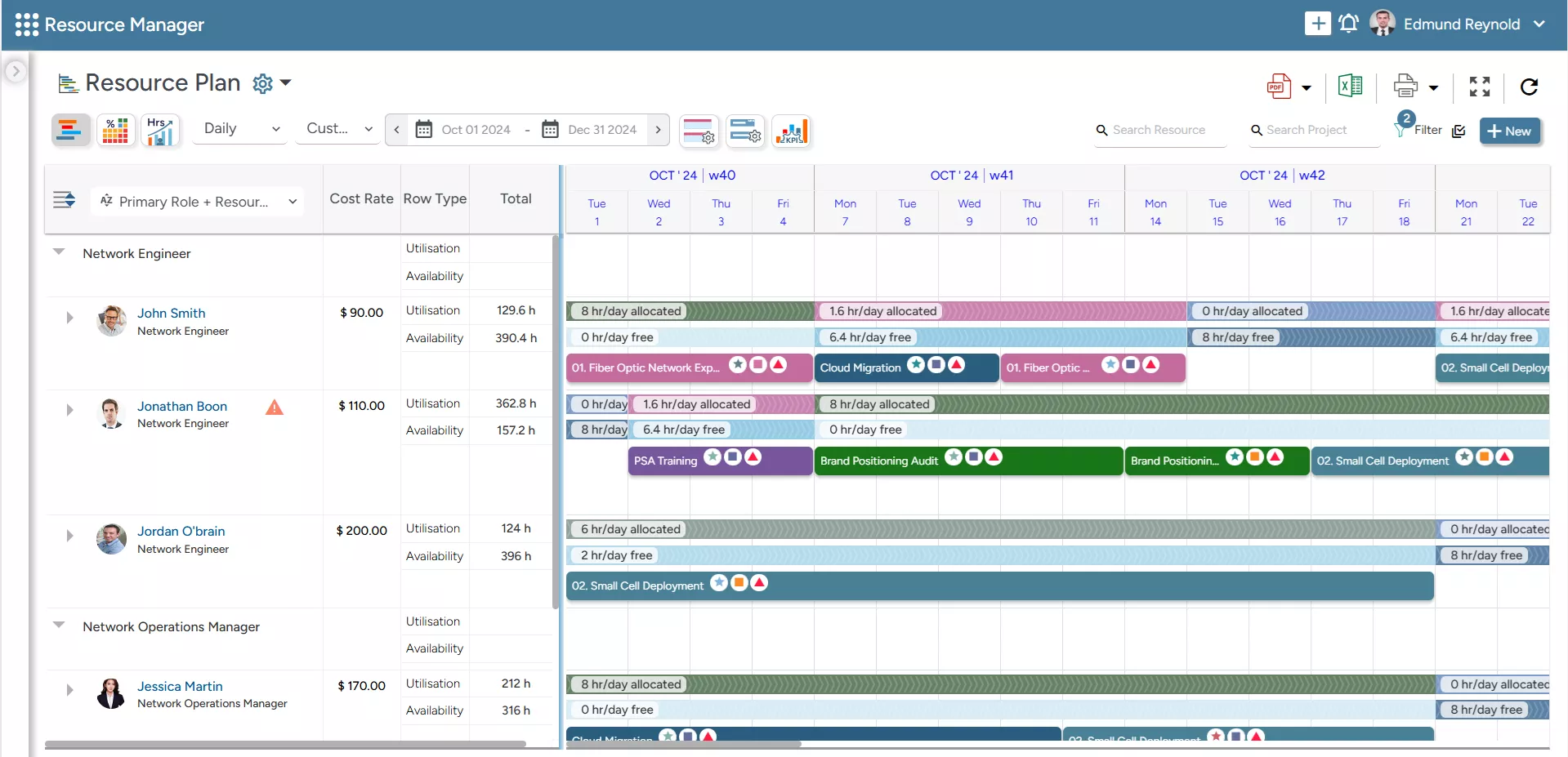
SAVIOM’s All-in-one Resource Planner offers centralized visibility into current and future resource schedules to enable better coordination and team planning.
- Next, the embedded capacity planner helps managers identify any resource excess or shortage in advance, allowing them to take corrective measures early and ensure timely project initiation.
- The other feature, intelligent matchmaking, helps assess employee skills, competencies, expertise, etc., to find the best-fit resources for tasks. It simplifies assigning tasks to the most competent team members, boosting work efficiency and quality.
- Next, the embedded heat map provides the utilization levels of each employee, which helps managers understand who is over/underutilized and ensure balanced work distribution within a team.
- The tool has a KPI forecaster, helps managers predict team-specific metrics like utilization rates, burnout rates, resource availability, etc., and makes proactive decisions.
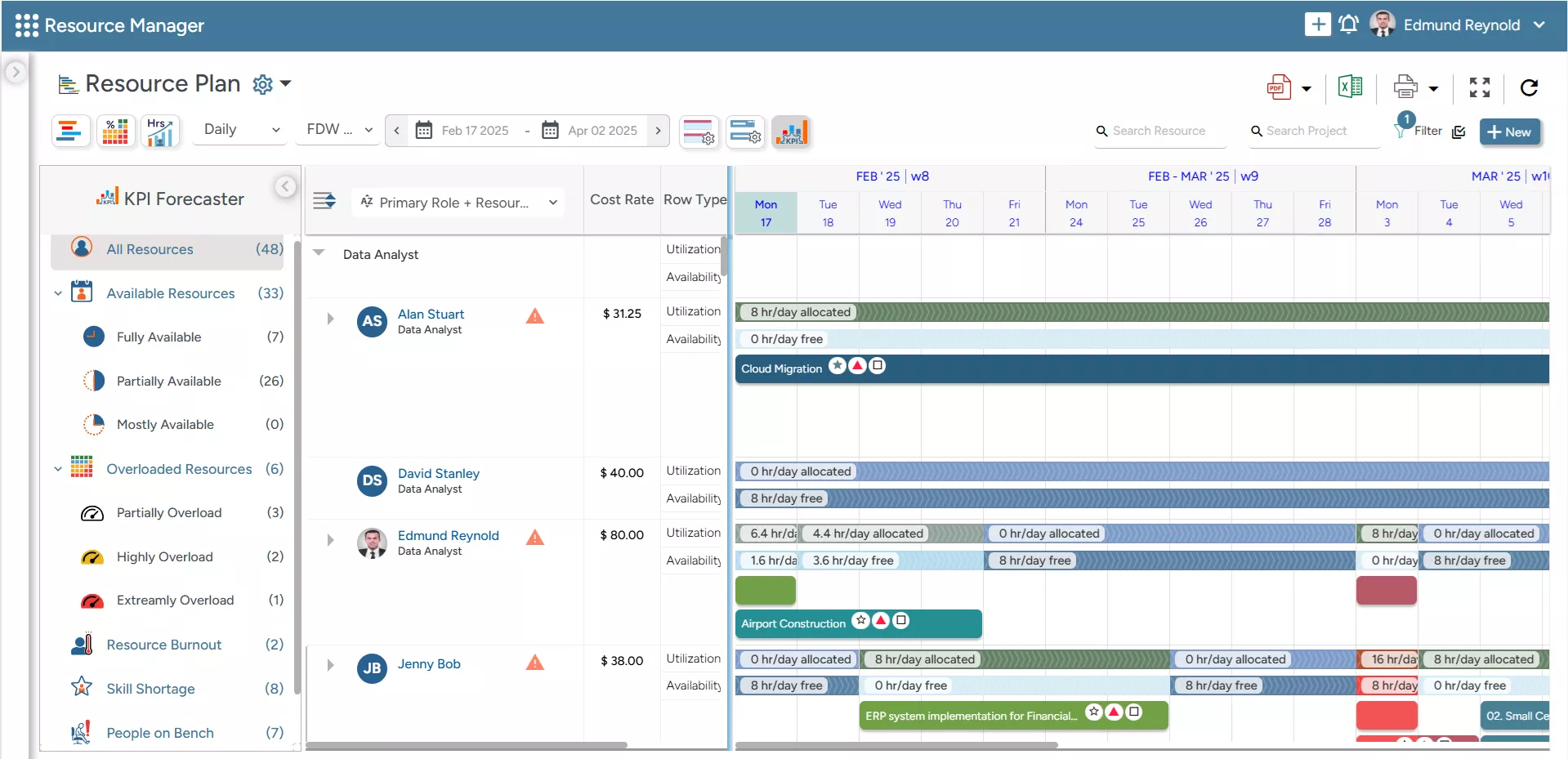
SAVIOM’s KPI Forecaster helps managers predict team metrics like utilization, burnout, skill shortage, and people on the bench to help managers plan and act early.
- The early warning system alerts the managers while team planning if the resources are double-booked or overloaded.
- The what-if scenario analysis helps managers simulate different planning scenarios to see which team plan works best. This helps avoid risks and delays by choosing the most effective resource plan before actual execution begins.
Conclusion
“Alone we can do so little; together we can do so much.” – Helen Keller, American author.
As the quote suggests, working together brings far greater results than working alone. Team planning makes this possible by aligning everyone toward common goals, clarifying roles, and ensuring the right people are available at the right time. It fosters a shared sense of direction and helps team members gain clarity on their role in achieving company goals.
The Glossary
Read More: Glossary of Resource Workforce Planning, Scheduling and Management




